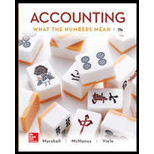
Case 8.36
LO 1, 2, 7
Capstone analytical review of Chapters 6-8. Analyzing capital leases, notes payable,
Mr. Gerrard: I’ve been talking with my accountant about our capital expansion needs, which will be considerable during the next couple of years. To stay in a strong competitive position, we’re constantly buying new pieces of earthmoving equipment and replacing machinery that has become obsolete. What it all comes down to is financing, and it’s not easy to raise $20 million to $40 million all at once. There are a number of options, including dealer financing, but the interest rates offered by banks are usually lower.
Your reply: From reviewing your
Mr. Gerrard: Actually we use several banks and we have an excellent credit history, so getting the money is not a major problem. The problem is that we already owe more, than $100 million and I don’t want to get overextended.
Your reply: Have you considered long-term leases?
Mr. Gerrard: Yes. This is essentially how dealer financing works. Usually it is arranged as a lease with an option to buy the equipment after a number of years. We’ve been actively looking into this with our Cat dealer for several scrapers that we need to put on a big job immediately. I can show you one of the contracts involved.
Your reply: OK, I’ll have a look at the contract, but this sounds like a long-term capital lease.
Mr. Gerrard: Yes, I think that’s what my accountant called it. What matters most to me is that we get the equipment in place ASAP; but if you could explain what the accounting implications would be of entering into these types of arrangements, that might put me at ease about it.
Your reply: No problem: will do. It would impact both your balance sheet and income statement, but in most respects a long-term capital lease is treated very much like a long-term note, payable, with a bank. I’ll give you a memo about it. But what about looking into other sources of equity financing? Have, you considered any of these options?
Mr. Gerrard: We’re a family business and want to keep it that way. Our shares are publicly traded, but we’re owned mostly by family members and employees. We’ve got a lot of
Should we be issuing bonds?
Your reply: Issuing bonds is possible, but I was thinking more on the lines of preferred stock. Are you familiar with this option?
Mr. Gerrard: Not really. Isn’t preferred stock a lot like bonds payable?
Your reply: Maybe this is something else I should include in my memo: an explanation of the differences between common stock, preferred stock, and bonds payable.
Mr. Gerrard: Yes, please do.
Required:
- When discussing capital leases with Mr. Gerrard, you commented, “It would impact both your balance sheet and income statement, but in most respects a long-term capital lease is treated very much like a long-term note payable with a hank.” Explain the accounting treatment of capital leases as compared to the accounting treatment of notes payable in terms that a nonaccountant could easily understand. Include in your answer both the balance sheet and income statement effects of capital leases. (Note: You do not need to make reference to the four criteria for capitalizing a lease.)
- Assume you have reviewed the contract Mr. Gerrard provided concerning the dealer financing agreement for the purchase of two new’ scrapers. You have determined that the lease agreement would qualify as a capital lease. The present value of the lease payments would be $4 million. Use the horizontal model, or write the
journal entry , to show Mr. Gerrard how page 311 this lease would affect the financial statements of Gerrard Construction Co. - Explain what Mr. Gerrard meant by this statement: “We’ve got a lot of retained earnings, but that’s not the same thing as cash, you know'.” Review the balance sheet at December 31, 2016, provided in Case 4.30. In which assets are most of the company’s retained earnings invested?
- Explain to Mr. Gerrard what the similarities and differences are between bonds payable, preferred stock, and common stock.
- Why would you recommend to Mr. Gerrard that his company consider issuing $20 million to $40 million of preferred stock rather than bonds payable? (Hint: Review the company’s balance sheet provided in Case 4.30 in the context of your present conversation with Mr. Gerrard.)
Want to see the full answer?
Check out a sample textbook solution
Chapter 8 Solutions
Accounting: What the Numbers Mean
- CALCULATING 3MS COST OF CAPITAL Use online resources to work on this chapters questions. Please note that website information changes over time, and these changes may limit your ability to answer some of these questions. In this chapter, we described how to estimate a companys WACC, which is the weighted average of its costs of debt, preferred stock/ and common equity. Most of the data we need to do this can be found from various data sources on the Internet. Here we walk through the steps used to calculate Minnesota Mining Manufacturings () WACC DISCUSSION QUESTIONS 1. As a first step, we need to estimate what percentage of MMMs capital comes from debt, preferred stock, and common equity This information can be found on the firms latest annual balance sheet. (As of year end 2017, had no preferred stock.) Total debt includes all interest-bearing debt and is the sum of short-term debt and long-term debt. a. Recall that the weights used in the WACC are based on the companys target capital structure. If we assume that the company wants to maintain the same mix of capital that it currently has on its balance sheet, what weights should you use to estimate the WACC for ? b. Find MMMs market capitalization, which is the market value of its common equity. Using the sum of its short-term debt and long-term debt from the balance sheet (we assume that the market value of its debt equals its book value) and its market capitalization, recalculate the firms debt and common equity weights to be used in the WACC equation. These weights are approximations of market-value weights. Be sure not to include accruals in the debt calculation.arrow_forward#15 Analyze the following: I – If interim financial statements are presented, only a statement of financial position and a statement of comprehensive income are required. II – Under cash to accrual and single-entry accounting related problems, accounts payable, trade notes payable, and advances to suppliers are prepared under one ledger because all these accounts are related to company supplier/s. III – When dilutive convertible bonds are the only potential ordinary shares, diluted EPS will be greater if the bonds are actually converted than not converted. Given these, we can conclude that: Group of answer choices Only statements I and II are true. Only statements I and III are true. Only statement II is false. Statement III is false.arrow_forwardAs requested, I include full question. only need answer part d) https://www.bartleby.com/questions-and-answers/q1.-consider-an-allequity-firm-that-is-contemplating-going-into-debt.-the-market-value-of-equity-is-/c24b4703-bc9d-4a3a-8d7f-8964bef82326 Consider an all-equity firm that is contemplating going into debt. The market value of equity is calculated as Free Cash Flow/required rate of return. Current ProposedAssets $10,000 $18,000Debt $0 $8,000Equity $10,000 $10,000Debt/Equity ratio 0.00 1.00Interest rate n/a 7%Shares outstanding 500 500Share price $20 $20 (a) If the required rate of return on unlevered equity is 10%, fill out the following table for the company before the debt is issued: Recession Expected ExpansionEBIT $500 $1,000 $1,500Interest 0 0 0Net incomeEPSROAROE (b) If the company adds the proposed amount of debt and EBIT is expected to expand proportionally, fill out the table in (a) after the debt is issued. (c) If an investor is not happy with the debt the company…arrow_forward
- 7. Use the information in Exercise 6, but assume instead that a 20% stock dividend was declared. Answer the same requirements. (see attached images especially for the information in Exercise 6 in the uploaded images. Please answer it. thank you so much) NOTE: Please answer letter a to barrow_forwardRequired information Problem 10-2A Record equity transactions and indicate the effect on the balance sheet equation (LO10-2, 10-3, 10-4, 10-5) Skip to question [The following information applies to the questions displayed below.] Donnie Hilfiger has two classes of stock authorized: $1 par preferred and $0.01 par value common. As of the beginning of 2021, 350 shares of preferred stock and 4,500 shares of common stock have been issued. The following transactions affect stockholders’ equity during 2021: March 1 Issue 1,600 shares of common stock for $47 per share. May 15 Purchase 450 shares of treasury stock for $40 per share. July 10 Resell 250 shares of treasury stock purchased on May 15 for $45 per share. October 15 Issue 250 shares of preferred stock for $50 per share. December 1 Declare a cash dividend on both common and preferred stock of $1.00 per share to all stockholders of record on December 15. (Hint: Dividends are not paid on treasury…arrow_forwardRequired information Problem 10-2A Record equity transactions and indicate the effect on the balance sheet equation (LO10-2, 10-3, 10-4, 10-5) Skip to question [The following information applies to the questions displayed below.] Donnie Hilfiger has two classes of stock authorized: $1 par preferred and $0.01 par value common. As of the beginning of 2021, 350 shares of preferred stock and 4,500 shares of common stock have been issued. The following transactions affect stockholders’ equity during 2021: March 1 Issue 1,600 shares of common stock for $47 per share. May 15 Purchase 450 shares of treasury stock for $40 per share. July 10 Resell 250 shares of treasury stock purchased on May 15 for $45 per share. October 15 Issue 250 shares of preferred stock for $50 per share. December 1 Declare a cash dividend on both common and preferred stock of $1.00 per share to all stockholders of record on December 15. (Hint: Dividends are not paid on treasury…arrow_forward
- Ma3. Please give only typed answer. [Checkbox: 1, 2, 3, or 4 options may be needed to form the correct answer]. Which of the following is a formula for a financial ratio? 1) earnings before interest and taxes / interest expense 2) (cash + marketable securities + A/R)/ current liabilities 3) average age of inventory/accounts payable period 4) (total shareholder equity-preferred stock) / shares outstandingarrow_forward7. Use the information in Exercise 6, but assume instead that a 20% stock dividend was declared. Answer the same requirements. (see attached images especially for the information in Exercise 6 in the uploaded images. Please answer it. thank you so much) NOTE: you can answer letter a to c or letter a to barrow_forward7. Use the information in Exercise 6, but assume instead that a 20% stock dividend was declared. Answer the same requirements. (see attached images especially for the information in Exercise 6 in the uploaded images. Please answer it. thank you so much) c) Compare with the accounts and figures given above and explain the effects of this stock dividend on the a) assets, b) liabilities, and c) shareholders' equity. d) Prepare again the shareholders' equity immediately after the stock dividend was distributed. Compare the accounts against no 1 above and explain the effects of this distribution on the a) assets, b) liabilities, and c) shareholders' equity.arrow_forward
 Fundamentals Of Financial Management, Concise Edi...FinanceISBN:9781337902571Author:Eugene F. Brigham, Joel F. HoustonPublisher:Cengage Learning
Fundamentals Of Financial Management, Concise Edi...FinanceISBN:9781337902571Author:Eugene F. Brigham, Joel F. HoustonPublisher:Cengage Learning Fundamentals of Financial Management (MindTap Cou...FinanceISBN:9781285867977Author:Eugene F. Brigham, Joel F. HoustonPublisher:Cengage Learning
Fundamentals of Financial Management (MindTap Cou...FinanceISBN:9781285867977Author:Eugene F. Brigham, Joel F. HoustonPublisher:Cengage Learning Cornerstones of Financial AccountingAccountingISBN:9781337690881Author:Jay Rich, Jeff JonesPublisher:Cengage Learning
Cornerstones of Financial AccountingAccountingISBN:9781337690881Author:Jay Rich, Jeff JonesPublisher:Cengage Learning Financial Reporting, Financial Statement Analysis...FinanceISBN:9781285190907Author:James M. Wahlen, Stephen P. Baginski, Mark BradshawPublisher:Cengage Learning
Financial Reporting, Financial Statement Analysis...FinanceISBN:9781285190907Author:James M. Wahlen, Stephen P. Baginski, Mark BradshawPublisher:Cengage Learning AccountingAccountingISBN:9781337272094Author:WARREN, Carl S., Reeve, James M., Duchac, Jonathan E.Publisher:Cengage Learning,
AccountingAccountingISBN:9781337272094Author:WARREN, Carl S., Reeve, James M., Duchac, Jonathan E.Publisher:Cengage Learning,





